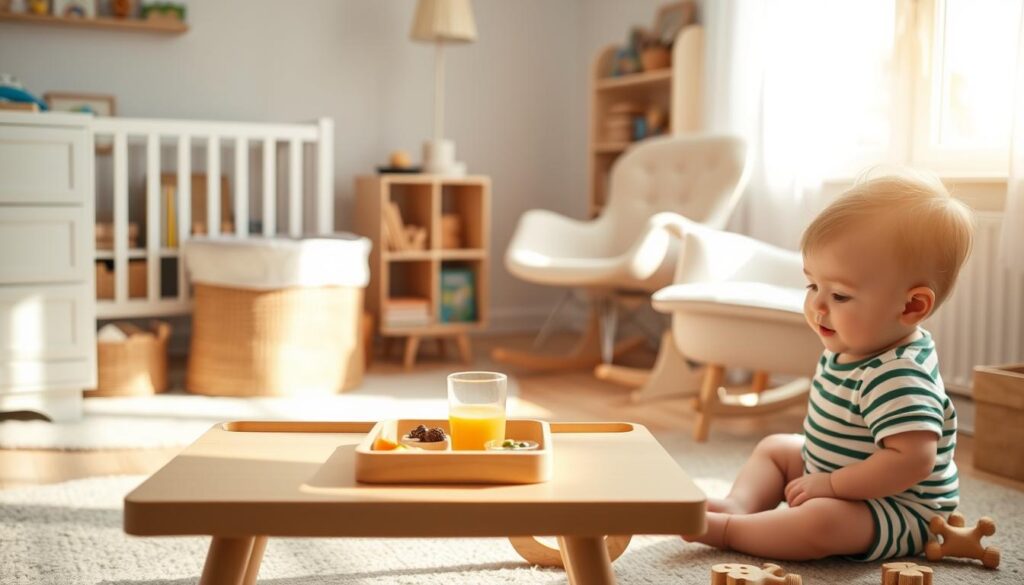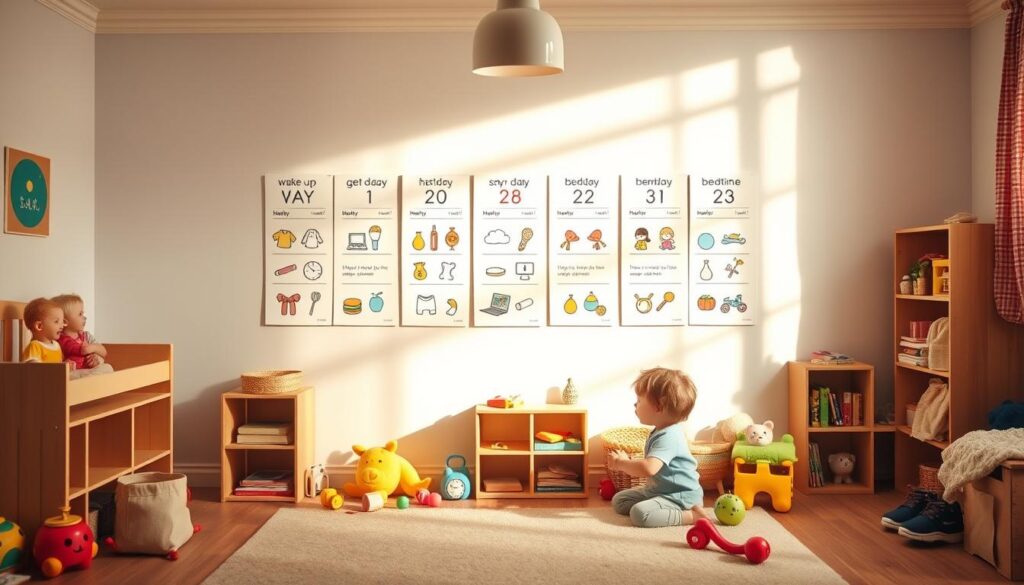Do you ever wonder why some toddlers seem more confident and secure than others? Is it possible that a simple daily schedule could be the key to unlocking your child’s full potential?
As a parent, you want the best for your child, and establishing a daily routine can have a significant impact on their overall well-being. Research has shown that children thrive on predictability, and a consistent daily routine can provide them with a sense of safety and confidence.
By implementing a daily routine, you can help your child develop essential life skills, such as self-regulation and independence. According to experts at Zero to Thrive, routines provide structure and predictability that toddlers crave, helping them feel secure in their world. A well-planned routine can also support your child’s cognitive, emotional, and social growth.
In this article, we’ll explore the importance of routines for toddlers and provide you with practical tips on how to establish a daily schedule that works for your family. We’ll also discuss how to balance consistency with flexibility to accommodate your child’s changing needs and moods.
Why Toddlers Thrive on Routine
A well-structured routine is essential for toddlers, promoting a sense of safety and predictability in their daily lives. When children know what to expect, they feel more secure and are better able to navigate their environment.
The Science Behind Structured Days
Experts explain that schedules create a sense of safety and confidence because they make a child’s environment predictable. This predictability allows children to focus on learning and mastering new skills, rather than wondering what’s next.
Creating a Sense of Security and Predictability
Routines help toddlers develop a sense of security and predictability, which is crucial for their emotional development. By knowing what’s coming next, toddlers can feel more in control and confident, leading to fewer tantrums and meltdowns.
- Predictable routines create an emotional safety net, reducing anxiety and helping toddlers feel secure.
- Knowing what comes next gives toddlers the confidence to try new things, with a secure base to return to.
- Routines help toddlers develop trust in their caregivers and environment, essential for healthy emotional development.
How Routine Supports Toddler Development
Routine is essential for toddlers, offering them a sense of security and stability that fosters development. By having a structured daily routine, toddlers can better understand and navigate their environment.
Cognitive and Emotional Benefits
A routine provides cognitive and emotional benefits for toddlers. It helps them develop a sense of predictability, reducing anxiety and stress. As toddlers follow a routine, they learn to anticipate what’s happening next, which supports their cognitive development. For instance, a consistent bedtime routine can signal to the child that it’s time for sleep, making the transition smoother.
Building Independence and Life Skills
Routines also encourage independence in toddlers by involving them in daily tasks. Simple activities like dressing, hand washing, and cleaning up help develop fine motor skills and problem-solving abilities. As toddlers master these tasks, they build confidence and self-esteem. For example, choosing their outfit or helping with meal preparation empowers them to take responsibility for their actions.
By participating in routines, toddlers develop essential life skills, including planning, sequencing, and following directions. These skills are crucial for future transitions, such as starting preschool. As toddlers learn to complete tasks independently, they develop a sense of capability and confidence.
Signs Your Toddler Needs a Better Routine
As a parent, recognizing the signs that your toddler needs a better routine can be a game-changer. A consistent daily schedule helps toddlers feel secure and develop essential life skills. But how do you know if your child’s routine is on track?
Behavioral Indicators
One of the primary signs that your toddler needs a better routine is a change in their behavior. If your child is becoming increasingly irritable, restless, or resistant to activities, it may be due to an inconsistent schedule. Research shows that toddlers thrive on predictability, and a lack of routine can lead to tantrums and meltdowns. For instance, if your toddler is having trouble transitioning between activities or is becoming overly demanding, it might be time to reassess their daily routine.
Sleep and Mood Patterns
Sleep disruptions, such as resistance to bedtime, frequent night wakings, or short naps, can signal that your toddler’s routine needs adjustment. According to sleep consultant Nicole Johnson, most toddlers consolidate their naps to one daytime sleep by 15 to 18 months, and maintaining a consistent naptime is crucial. A predictable daytime routine promotes better nighttime sleep, as found in studies reviewed in 2018. If your toddler is waking up grumpy or having trouble settling down at night, it might indicate that their daily rhythms are out of sync.
Moreover, overtiredness from missed naps or late bedtimes can create a cycle of poor sleep and difficult behavior. By recognizing these signs and adjusting your toddler’s routine accordingly, you can help break this cycle and promote a more restful and predictable sleep pattern.
Key Elements of Effective Toddler Routines
A well-planned routine is essential for toddlers’ growth and well-being. It provides a sense of security and predictability, which is crucial for their development.
Consistency vs. Flexibility
Striking a balance between consistency and flexibility is vital in routines for toddlers. While consistency provides a sense of security, flexibility allows for adjustments according to the child’s needs and unexpected events.
Age-Appropriate Expectations
Understanding the typical developmental capabilities of toddlers at different ages is key. For instance, children aged 12-18 months need simple routines with visual cues, while those aged 2-3 years can follow more complex routines involving multiple activities.
| Age Group | Routine Characteristics | Examples of Activities |
|---|---|---|
| 12-18 months | Simple, visually cued | Bath time, reading |
| 18-24 months | More interactive | Singing, simple games |
| 2-3 years | Complex, multi-step | Dressing, simple chores |

Creating a Morning Routine That Works
Toddlers thrive on routine, and the morning is a crucial time to set a positive tone for the day. A well-structured morning routine helps your child transition smoothly from waking up to engaging with their day.
Wake-Up and Breakfast Strategies
Starting the day on a positive note involves a gentle wake-up and a nutritious breakfast. You can make mornings more enjoyable by using a wake-up light or a favorite song. For breakfast, offer a variety of healthy options to keep mealtime interesting. Consistency is key; establish a routine that works for you and your toddler.
- Use a gentle wake-up method, such as a wake-up light or a favorite song.
- Offer a variety of healthy breakfast options.
Morning Activities and Transitions
After breakfast, it’s an excellent time for some unstructured play, allowing your toddler to explore and express themselves. You can also incorporate necessary chores into the morning routine, making it a fun, collaborative experience. Using songs, games, or visual cues can help make transitions between activities smoother.
- Incorporate unstructured playtime to foster creativity and independence.
- Use songs, games, or visual cues to facilitate smooth transitions.
Structuring Afternoon Routines for Toddlers
A consistent afternoon routine is essential for toddlers, helping them develop emotional regulation and life skills. As a parent, you’re likely aware that a well-structured afternoon can make a significant difference in your child’s overall happiness and development.
Balancing Play, Learning, and Rest
Your toddler needs a balance of play, learning, and rest in the afternoon. Playtime is crucial as it allows your child to engage with their environment and develop their cognitive skills. Try rotating toys daily or weekly to keep things fresh and exciting. For instance, you can offer a healthy snack like fruit with plain yogurt or veggies with hummus to keep them energized.
Managing the Post-Nap Period
After a nap, toddlers often experience grogginess or crankiness. To manage this transition, establish a calming post-nap ritual, such as reading a book or singing a soothing song. This helps your child reorient and prepare for the rest of the day. You can also offer a nutritious snack to boost their energy levels. Some ideas for afternoon activities include outdoor play, puzzles, or creative arts, tailored to your toddler’s energy levels after rest time.
As your child grows, their afternoon routine may need to adapt. Be prepared to adjust the schedule when they begin to transition away from napping altogether. Consistency is key, even when naps are missed or shortened. By maintaining a consistent afternoon routine, you can help your toddler feel secure and develop healthy habits that will benefit them in the long run.
Designing a Calming Evening Routine
A calming evening routine helps signal to toddlers that it’s time to wind down. This routine is essential for their development and overall happiness.
Dinner and Family Time
Dinner and family time are crucial components of the evening routine. Sharing a meal together fosters a sense of togetherness and allows for quality time with your toddler. Make dinner a positive experience by turning off the TV and engaging in conversations.
Use this opportunity to teach your toddler about social skills, such as taking turns and using good manners.
Bedtime Rituals That Promote Sleep
Establishing a consistent bedtime ritual can significantly improve your toddler’s sleep quality. Activities like bath time, reading, or singing lullabies create a soothing atmosphere, helping your toddler relax.
Keep the lights dim and play soft music to create a cozy environment. A calming bedtime routine helps your toddler feel secure and relaxed, making it easier for them to fall asleep.
How to Involve Toddlers in Their Daily Routine
Empowering toddlers to take part in their daily schedule can foster independence and confidence. Involving them in the routine not only teaches them important life skills but also makes the process smoother for parents.
Offering Age-Appropriate Choices
Offering choices is a great way to involve toddlers in their routine. You can allow them to choose between two healthy breakfast options or pick out their clothes for the day. This simple act of choosing gives them a sense of control and agency. For example, you can say, “Do you want oatmeal or scrambled eggs for breakfast?” This not only involves them in the decision-making process but also teaches them about making choices.
Using Visual Schedules and Cues
Visual schedules can be incredibly helpful for toddlers, especially those with special needs. Using pictures or icons to represent different activities can make it easier for children to follow along. You can create a chart that outlines the day’s events, allowing toddlers to see what’s coming next. For instance, displaying a series of pictures near the sink can remind children of the hand-washing steps.  To learn more about establishing effective bedtime routines, check out our tips on bedtime stalling tactics.
To learn more about establishing effective bedtime routines, check out our tips on bedtime stalling tactics.
Handling Transitions Within Your Routine
One of the most significant challenges parents face is managing transitions within their toddler’s routine without causing distress. Transitions are an inevitable part of daily life, and learning to navigate them smoothly can greatly benefit your child’s development.
Managing Meltdowns
To prevent meltdowns during schedule changes, it’s essential to prepare your toddler in advance. You can do this by giving them a heads-up about the upcoming transition, using simple and clear language. For example, you might say, “In five minutes, we’re going to clean up and have a snack.” This warning helps your child adjust to the change.
Using Songs and Signals
Using songs and signals is another effective way to make transitions smoother. Singing a special song during transitions can be both fun and calming. For instance, you can sing a “clean-up” song while picking up toys, making the task more enjoyable. You can also use visual signals, like a special gesture or a puppet, to cue your child that it’s time to move on to the next activity. By incorporating these techniques into your daily routine, you can reduce stress and make transitions a positive experience for your toddler.
- Prepare your toddler for transitions with advance notice.
- Use songs and rhymes to make transitions enjoyable.
- Employ visual signals to cue upcoming transitions.
Adapting Routines for Special Circumstances
Life is full of unexpected events, and learning to adapt routines for special circumstances can make a significant difference in managing daily life with toddlers. Whether it’s travel, holidays, illness, or managing multiple children with different needs, being flexible is key.
Travel and Holidays
When traveling or celebrating holidays, maintaining some elements of the routine can provide comfort to toddlers. Pack familiar items like favorite toys or blankets to create a sense of security. Adjusting expectations and being patient during these times is also crucial.
Illness and Disruptions
During illness or disruptions, routines may need to be adjusted to accommodate the child’s needs. Offering extra comfort and adjusting schedules as necessary can help. It’s also important to get back to the regular routine as soon as possible.
Multiple Children with Different Needs
Managing routines for multiple children requires finding a balance that works for everyone. Creating a family calendar can help in visualizing and managing different schedules. Involving older siblings in caring for toddlers can also be beneficial, teaching them responsibility and empathy.
Common Routine Mistakes and How to Avoid Them
Toddlers thrive on routine, but certain missteps can undermine the benefits and create unnecessary challenges for parents. Building a routine takes time and patience. Consistency is key to helping toddlers adapt to their daily schedule.
Overscheduling Your Toddler
One common mistake is overscheduling, which can lead to stress and exhaustion in toddlers. A balanced routine should allow for a mix of structured activities and free play. Parents should be mindful of their child’s cues and avoid packing the schedule too tightly.
Inconsistency and Its Effects
Inconsistency in routines can be confusing for toddlers, leading to increased behavioral challenges. For instance, irregular bedtimes can disrupt sleep patterns. To avoid this, parents should strive to maintain a consistent schedule, even on weekends. This helps regulate a child’s internal clock, making transitions smoother.
| Consistency Aspect | Benefits |
|---|---|
| Regular Wake-Up Times | Regulates daily rhythm |
| Consistent Meal Times | Establishes eating habits |
| Predictable Bedtimes | Improves sleep quality |
By being aware of these common mistakes and taking steps to avoid them, parents can create a routine that supports their toddler’s development and happiness.
Conclusion: Building Lifelong Benefits Through Routine
The power of routine in shaping a toddler’s life is both profound and multifaceted. By establishing a consistent daily structure, parents can foster emotional security, independence, and a love for learning in their children. This, in turn, sets the stage for a positive and enriching childhood.
The benefits of a well-designed routine are numerous. Toddlers develop essential executive function skills like self-regulation, planning, and time management, which benefit them throughout their lives. A predictable routine also gives toddlers the confidence to explore, take risks, and develop independence in healthy ways.
By prioritizing consistency while remaining adaptable to change, parents can create an environment where toddlers thrive. Remember, the goal of a routine is not rigid adherence to a schedule but creating a framework that helps toddlers make sense of their world and feel secure within it.
FAQ
How do I establish a daily schedule that works for my child?
To create a schedule that works, consider your child’s age, needs, and personality. Start by setting a consistent wake-up time and bedtime, then fill in the day with a balance of play, learning, and rest. Be flexible, as it may take some trial and error to get it just right!
What are some signs that my child’s daily routine needs adjustment?
If your child is having trouble sleeping, is irritable or cranky, or is having behavioral issues, it may be a sign that their daily routine needs a tweak. Look for patterns and try adjusting their schedule accordingly.
How can I involve my child in their daily routine?
Encourage your child to take ownership of their daily routine by offering age-appropriate choices, such as choosing what to wear or what book to read before bed. You can also use visual schedules and cues to help them stay on track.
What are some strategies for handling transitions within our daily routine?
To make transitions smoother, try using songs and signals to help your child know what’s coming next. You can also prepare them in advance by giving a warning, such as “we’re going to leave the park in 5 minutes.”
How can I adapt our daily routine for special circumstances, like travel or illness?
When traveling or dealing with illness, try to maintain as much of your child’s regular routine as possible. This can help provide a sense of security and comfort during a time of change. Be flexible and adjust as needed to accommodate your child’s needs.
What are some common mistakes to avoid when creating a daily routine for my child?
One common mistake is overscheduling, which can lead to a child feeling overwhelmed and stressed. Another is being inconsistent, which can make it hard for a child to know what to expect. Try to strike a balance between structure and flexibility.




